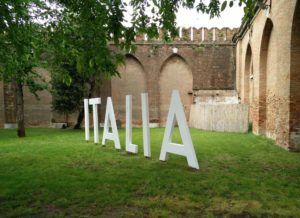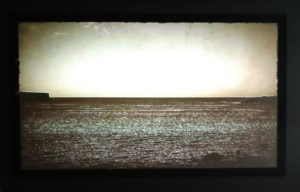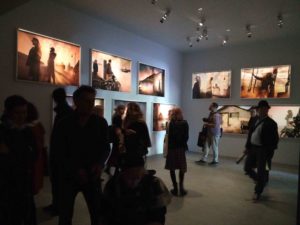 The 57th Venice Biennale is coming towards its end, an occasion to review three national contributions in the Giardini and the Arsenale. In the Italian Pavilion there are three artists approaching our common memory and present in a magical way. Whereas Geoffrey Farmer in the Canadian Pavilion targets his personal history with a glance to the general. Tracey Moffatt recounts stories aiming to historical or fictional events. Nevertheless, she keeps the present in view.
The 57th Venice Biennale is coming towards its end, an occasion to review three national contributions in the Giardini and the Arsenale. In the Italian Pavilion there are three artists approaching our common memory and present in a magical way. Whereas Geoffrey Farmer in the Canadian Pavilion targets his personal history with a glance to the general. Tracey Moffatt recounts stories aiming to historical or fictional events. Nevertheless, she keeps the present in view.
Italy – Il mondo magico (The magical world)
The largest pavilion is the one of the host country Italy. After some years with numerous different artists this year’s curator, Cecilia Alemani, restricted herself to invite only three creatives to fill vast space. By entering the visitor plunge into a veritable mystic sphere, like the title of the exhibition “Il mondo magico” (The magical world) promises.
In subdued light dominates a tunnel of transparent air cushions, with lateral chambers. Herein lying sculptures in pose of the crucified Jesus. Inspired by the medieval book “The Imitation of Christ”, Roberto Cuoghi did not instruct to spiritual life, like the manual of devotion, but reinterprets it with view to a “new technological materialism”. In fact, he takes aim to our collective iconographic memory of art history. Surrounded by machines, used to produce the sculptures, the whole installation is a laboratory. Furthermore, the exhibited sculptures parts remind archaeological sites with a certain morbid fascination. At the same time, the installation is a little bit creepy.
Also the next room is dimmed lighted. Only some light chains and the reflex of the video screen illuminate the scene. Adelita Husni-Bey shows a film about a workshop with young people earlier this year, where they reflect about current issues like environment, exploitation, technology and vulnerability confronted to tarot cards as magical element in the discussion. “The reading/La Seduta” is a critical review about our society with the aspiration to the spectators to consider their own behaviour with regard to present problems.
Even though Adelita Husni-Bey’s work might be illumination for the spirit, the third space, shaped by Giorgio Andreotta Calò is even more obscur than the other two. When the eyes are accustomed to the darkness, one can recognise a construction out of scaffolding poles and stairs at the rear wall leading to the upper level. Climbing these stairs, the view opens to a fascinating scene. The before seen scaffolding serves as basis to a huge surface, reflecting the wooden roof structure of the whole building. At first glance, the plane seems to be an oversized mirror. In truth, it is water, which reproduces the ceiling inverted. Water is a recurrent motif of the in Venice born artist, both, as nourishing source and destructive force. Here in Venice Giorgio Andreotta Calò created an unseen mythical twilight world, which also is inspired also by Ernesto De Martino’s book “La fine del mondo” like the title “Untitled (The end of the world)” indicates. The author describes the ancient Roman myth about a door between here-and-now and the worlds beyond.
Geoffrey Farmer calls as well the spirits of the past and uses water in his installation for the Canadian Pavilion. Nevertheless, it is illuminated by the bright daylight.
Canada – A way out of the mirror
For his installation, “A way out of the mirror” Geoffrey Farmer benefited from the fact that the Canadian Pavilion will be renovated until next year. This created the possibility to partly deconstruct the building and search for its fundaments. Literally there should be the debris of the by Napoleon destroyed Castello quarter under the actual exhibition ground of the Giardini. In a broader sense, it is a research about the pavilion’s history as a construction financed by war reparation money and history in general.
On view is a fountain in the centre of the pavilion. It is spitting water like a geyser. That seems to be a representation of the destructive force of water because it had spread away half of the roof. There are planks lying all around. Besides the central well there are smaller other water bearing sculptures and artificial plants. Even on sunny days, it splatters and trickles everywhere.
However, Geoffrey Farmer’s issue is not devastation, but the artist wants to come to terms with the past, the general and in this case more his personal. As his sister sent him two photos of a collision between a train and a lumber truck driven by his grandfather, the way back in the family history was opened. The dispersed bars are symbol for the power of the shock of the grandfather accident, illustrated by the images. Moreover, they stand for the suffered paternal violence, committed by his father unable to express his feelings otherwise. To recognise, that this brutal behaviour was not justified by the child’s conduct, opened a new view to the family history. In consequence, the exploding water stands for the liberation to comprehend the source of the own injuries/ intergenerational trauma.
Additional surrounding elements of the installation refer to other life stages of the artist, like the well from the San Francisco Art Institute, where he studied. At the same time, it is a personal reference and a hint to local Gay-Community, its culture and its threat by aids.
A mirror, like the title “A way out of the mirror” promises, is not to find. Whereas there is a bronze cast of an enlarged page of an Allen-Ginsberg-publication. It shows the poem where the quote is taken from, to indicate, that the installation is the attempt to pass beyond the misinterpretation of history.
History is as well an issue of the Australian Pavilion. However, Tracey Moffatt illuminates in “My Horizon” more or less personal memory and refers to the present. Her stories are reflecting individual fates like Geoffrey Farmer, but they have at the same time a universal direction.
Australia – My Horizon
 In contrast to the Italian Pavilion, the in 2015 new built Australian Pavilion is plunged into a comfortable twilight. Also, there is no need to work literally with water, like in the open-air pavilion of Canada, since the building is the only direct water-facing in the Giardini. Nevertheless, Tracey Moffatt’s journey through the time starts with a film, showing most of all the panoramic view of the entrance to Sydney Harbour.
In contrast to the Italian Pavilion, the in 2015 new built Australian Pavilion is plunged into a comfortable twilight. Also, there is no need to work literally with water, like in the open-air pavilion of Canada, since the building is the only direct water-facing in the Giardini. Nevertheless, Tracey Moffatt’s journey through the time starts with a film, showing most of all the panoramic view of the entrance to Sydney Harbour.
The two-minute-long video “The White Ghosts Sailed” pretends to be turned by the Indigenous eyewitnesses on 26 January 1788, when the British First Fleet arrived in Sydney to colonise the Australian continent. Due to its age, the quality is degraded by the decay of the old nitrate films. Therefore, there are no images of the direct landing, but the sound implies the action by military music. Apart from that, “ghosts” seem to float over the water surface. Are they the spirits of the colonial past?
With the photo series “Body Remembers” Tracey Moffatt takes us to the more recent past. Dressed in a black-and-white maid’s uniform, with upswept hair like in the 1950s, the artist herself becomes protagonist of ten photographs in vintage style. Starting with an image of the remains of a house – somewhere in no-mans-land – it could be a journey into the past of her or someone else. In the following, there are pictures of the actress in the ruin and some with her in an inhabited domicile. Are these the reflexions of a past? Even if the story seems to be clear at first glance, every spectator could find another context. An explicit information is not given and some inconsistencies in the photos let think more to surrealism than reality. For example, in the opening photo of the ruin is a shadow of a person, but there is no logical explanation from where it comes; a petroleum lamp is lit, even so, the bright daylight is falling through the window.
 Alike, the second photo series, “Passage” seems to be a set of film stills. Here, the images remind more to the film noir of the 1940s. Nevertheless, the story is even vaguer, the title and the explanation by Tracey Moffatt point to the direction that the series is about crossing borders. A woman with a baby is standing in afternoon twilight on a pier; smoke is spreading in front of a house; the woman and a biker are watching a ferry; the biker, probably a policeman, is holding the baby. Once again, it is the part of the viewer to decide, for example if the policeman is the saviour or the snatcher.
Alike, the second photo series, “Passage” seems to be a set of film stills. Here, the images remind more to the film noir of the 1940s. Nevertheless, the story is even vaguer, the title and the explanation by Tracey Moffatt point to the direction that the series is about crossing borders. A woman with a baby is standing in afternoon twilight on a pier; smoke is spreading in front of a house; the woman and a biker are watching a ferry; the biker, probably a policeman, is holding the baby. Once again, it is the part of the viewer to decide, for example if the policeman is the saviour or the snatcher.
 On the contrary, the second video “Vigil” (2 minutes) clearly refers to the current migration over the sea. However, the images of a capsizing refugee boat are juxtaposed to movie close-ups of Hollywood actors like Elizabeth Taylor, Kathleen Turner and Donald Sutherland. The stars are looking through windows. By the alternating cut and the changing expressions of the actors, it seems that they are watching the accident with growing horror. In December 2010, the artist saw images of drowning asylum seekers on TV and was shocked. With “Vigil” she holds a mirror in front of us, to alarm us, that we are only regarding the catastrophe with dismay, like the cut-in stars in the film.
On the contrary, the second video “Vigil” (2 minutes) clearly refers to the current migration over the sea. However, the images of a capsizing refugee boat are juxtaposed to movie close-ups of Hollywood actors like Elizabeth Taylor, Kathleen Turner and Donald Sutherland. The stars are looking through windows. By the alternating cut and the changing expressions of the actors, it seems that they are watching the accident with growing horror. In December 2010, the artist saw images of drowning asylum seekers on TV and was shocked. With “Vigil” she holds a mirror in front of us, to alarm us, that we are only regarding the catastrophe with dismay, like the cut-in stars in the film.
All the oeuvres have in common that they are describing horizons: cultural, social, historic or political. A glance in Tracey Moffatt’s mirrors might enlarge our self-conception.
Sources:
http://www.labiennale.org/it/arte/2017
Italy – Il mondo magico:
http://www.ilmondomagico2017.it
http://www.labiennale.org/en/art/2017/italian-pavilion
https://radiopapesse.org/en/archive/interviews/adelita-husni-bey-the-reading
Canada – A way out of the mirror:
https://kunstforum.de/lesen/artikel.aspx?a=247026
http://moussemagazine.it/geoffrey-farmer-canada-pavilion-venice-biennale-2017/
http://www.kunstgiesserei.ch/kuenstlerwerke/geoffrey-farmer/sfai-fountain-planks-sign-2017/
http://canadianart.ca/news/details-released-geoffrey-farmers-venice-biennale-show/
Austratia – My Horizon:
https://www.theguardian.com/artanddesign/2017/may/10/tracey-moffatt-my-horizon-australia-pavilion-venice-biennale
https://www.inexhibit.com/it/case-studies/tracey-moffatt-my-horizon-padiglione-australiano-biennale-venezia-arte-2017/
Media release http://www.australiacouncil.gov.au/ (no longer available)















